
Stories presented in this post:
Plastic Man - "No One Can Stop the Vanishers"
(writer unknown, pencils and inks thought to be by Alex Kotzky)
Police Comics #89 (Apr. 1949)
Plastic Man - "The Dictator of Dreams"
(story and pencils by Jack Cole, inks thought to be by Alex Kotzky)
Police Comics #78 (May, 1948)
Welcome to the 50th article posted on Cole’s Comics!
To start the festivities, I’d like to announce that I am putting together a book proposal for what would basically be a book version of this blog. I will be shopping this around to various publishers. If there’s anybody out there in the publishing industry, or with connections to such that would be interested in seeing the proposal, please contact me!
As time goes on, I’ll be sharing more about this project. I welcome your thoughts or comments. For those kind folks who comment and send email helping to develop this critical analysis of Cole’s art, I will happily include your name in the acknowledgements section of the book.
I also would like to announce that a new FUZZY one-pager, from Modern Comics #78 (Oct. 1948) has been discovered and posted in the article previously written about this series.
Now, for the treat promised for this posting!
In honor of the occasion, I thought we’d begin to look at the last work Jack Cole did on PLASTIC MAN. I have a very special story to share with you in this post – one of my favorites in the entire Plastic Man series.
The popular and ground-breaking Plastic Man Archives reprint series seems to have stalled out at Police Comics #77. It’s been three years since the last volume. In the last 25 or so issues of Police Comics that featured Plastic Man stories, there are about 15 stories that Jack Cole wrote, penciled, and in a few cases, also inked. There are also several Cole stories in the last original issues of Plastic Man during the same period.
These stories are intensely strange and filled with amazing graphic storytelling innovations. As time goes on, we’ll look at several of these heretofore unseen gems.
Police Comics #78 featured one of the strangest stories Jack Cole ever made… and that’s saying a lot! “The Dictator of Dreams” is a story that Jack Cole wrote and penciled. It was inked by someone else. In his 1986 book, Focus on Jack Cole, Ron Goulart suggested that perhaps the inker on this story was Alex Kotzky.
In early 1946, other artists began to work on the enormously popular PLASTIC MAN Series. It has been written that when he was told that it would be necessary to bring other artists into his creation, Jack Cole wept.
Like most artists working in early comics, Jack Cole did not legally own his creation. His publisher destroyed his pages of original art, and when it became profitable to do so, hired other writers and artists to create Plastic Man stories.
This sad situation may have contributed to Jack Cole’s decision to leave the comic book industry and later refer to it in very negative, dismissive terms.
Seen from this perspective, Cole’s career divides into two phases. The first is a heady period of expansion and excitement covering 1938 to 1945, in which Cole did everything on most of his stories in this period, writing, drawing, inking, lettering, and even probably coloring. The second phase, from 1946- 1953, is characterized by stretches of diluted, compromised work shot through with flashes of startling brilliance and mature artistic vision.
For the last half of his 16 year career in comics, Jack Cole was forced on a regular basis to dilute his work by allowing others in. This may also explain why he worked on several obscure short filler features in the pages of Quality comics, in which he was allowed to reign again as the sole creator for brief periods.
On the rare occasions in this second phase when a story is 100% Cole, it is usually a highly dense, compressed bouillon cube of creativity.
There is a vast difference between reading a Plastic Man story written and at least pencilled by Jack Cole, and one that was made by other hands entirely. According to Jim Steranko, writers of Plastic Man include: Bill Woolfolk, Manly Wade Wellman, Gwenn Hansen, Harry Stein, and the famous crime novelist Mickey Spillane. According to Ron Goulart, the artists known to have worked on Plastic Man include: Bart Tumey, Andre LeBlanc, John Spranger, Bill Ward, and Alex Kotzky. Steranko provides his own list of names, all of which are different than Goulart's: Lou Fine, Gill Fox, Charles Nicholas, Ruben Moreira, and Al Bryant on pencils with John Belfi and Robin King on inks.
About ten years younger than Jack Cole, Alex Kotzky was a dedicated fan and protégé of Cole’s, and probably the best imitator of Cole’s magic. He is best known for his long running newspaper strip, APARTMENT 3-G.
Here is a story, from Police Comics #89 (Apr. 1949) that Ron Goulart credits Alex Kotzky with penciling as well as inking. It is useful to compare with the stories that Cole penciled. One can note several Cole-isms in this story, including a panel with quivering borders (mostly famously used in the needle in the eye scene from “Murder, Morphine and Me”), the integration of sound effects as part of the overall design, and the dynamic page layouts. The characters are comically exaggerated in the way that Cole developed, and they move at manic speeds with lots of little puffs of dust and speed lines, just as Cole did. There’s even a face-changing panel, which was one of Cole’s recurring visual motifs and story concepts.
Despite all this, something very important is lacking. Read the story and see for yourself.


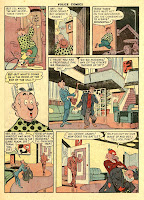
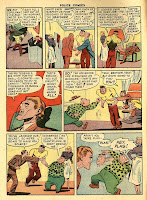




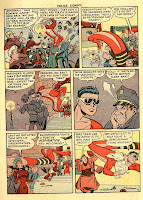
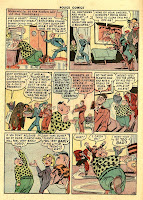
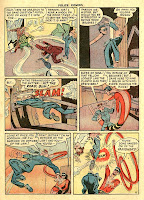




This story, for all it’s lively art and use of Cole’s patented graphic storytelling devices, just isn’t much FUN. It’s filled with logical inconsistencies in both the plot line (such as the usually impeccable law man Plas inciting gunplay into a crowd of innocents), and the art (such as the jumpiness of how Woozy discovers the crook’s lair in the top tier of page 3).
Now, for the real deal… here’s the great “Dictator of Dreams,” from Police Comics #78.
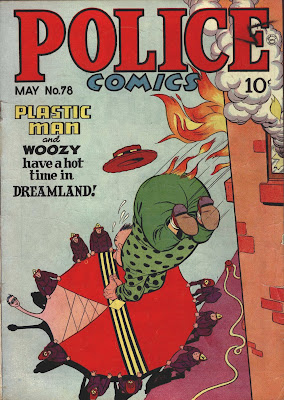






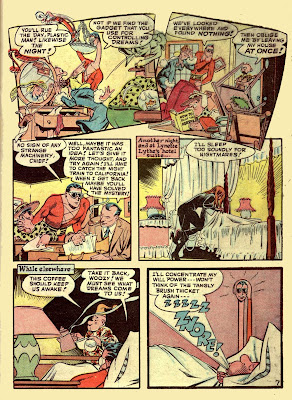

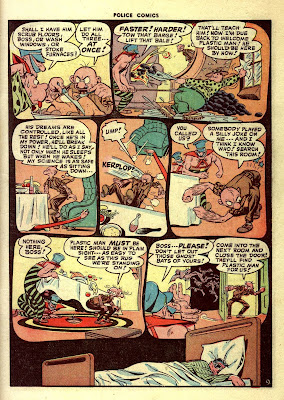






This story is filled with amazing elements. First, there’s the concept of the story itself, which falls in with Jack Cole’s recurring theme of crazy inventions and their equally crazy inventors. The story is highly entertaining, with a novel concept, a highly sexy female, great comedy bits, and a satisfying resolution.
After a compelling fake-out opener in which a dream is presented as reality, Cole invents a whole new page design to help the reader clearly know when we’re in the dream world and when the story takes place in the waking “real” world.
These pages are particularly beautiful, with organically shaped panels inhabiting black backgrounds, instead of the customary white. The astonishing splash page beautifully sets the tone with the organic black backgrounds and loose, almost Alexander Calder-like line work. These drawings don't look quite like normal comic book drawings, creating an otherworldly effect right away.
Pages 8 and 9 are compliments of each other, and work both as single pages, and as a double-page spread. Because Plastic Man and Woozy are dreaming the same dream, the design is particularly effective, because it effortlessly shows us this.
In the last sequence, when we shift out of the dream for the last time, note how Cole draws gradient lines in the background to transition into the bottom tier. Cole may have been influenced by similar techniques used by Will Eisner in his SPIRIT stories, but he made the device work in service of his story, which shows a certain mastery, and not just visual pyrotechnics for their own sake.
This story also includes some of C ole’s most risqué female drawings in is entire Plastic Man series. Lynette Lythe (love that name!) is a lovely character to look at. She is literally the girl of everyone's dreams in this story. The sexy silhouette of her going to bed in panel four of page 7 is especially strong, even for Cole, showing the influence of his work on the gag cartoons he was selling to men's magazines by this time.
Cole feels totally and completely invested in this story, as much as he was in his 1940 DICKIE DEAN stories, or his early MIDNIGHT stories. When you consider the career of Jack Kirby, who mostly only pencilled his pages and left the inking to Joe Simon and many others, it seems a shame that Cole couldn't have come to feel more comfortable with this arrangement. Perhaps, since he had been doing it all himself from the start, the shift to include other hands in his creations was just too difficult for him.
In a few cases, such as this outstanding story, Cole was able to make the new working arrangements -- in which he was no longer the dictator of his creations -- work for him. In future postings, we'll look at a few more of these gems.

You know, I feel like a real cad ragging on Alex Kotsky's story because after all, it's very good, but who wouldn't suffer by comparison to Cole? Especially when we're talking about Plastic Man? The story and the art of that first story just aren't up to snuff, are they?
ReplyDeleteThis post was a really great idea. Very instructive. Comparing these two essentially contemporaneous tales is a striking way to point up the many gifts Cole possessed as a comics story teller -- gifts few others ever even understood.
And finally, somebody else is talking about the remarkable quality of Cole's later Plas stories. You're right on about your observations as to why this is the case. It's not only because he'd honed his skills later in life, but being unable to do more work forced Cole to shoehorn all his energies and ideas into the few pages he could manage to produce.
Everything you site about the imaginative and effective nature of the art is on the money, but then there's the proliferation of sight gags; one in just about every panel, and some are just amazing. The final panel on Page Ten is hilarious and beautiful!
Once again, I could spend hours writing about this single Cole story, but then you wouldn't have any room for other comments, and besides, isn't that your job? Thanks so, so much for this and all your posts, Paul. Well worth the effort, but you knew that.
I like the way Cole seems to slow down the action at the bottom of page two. In the last panel, Woozy almost appears to be floating in space, not falling. Cole was better than anyone when it came to suggesting movement (look at page 14) so I doubt that it was an accident. The effect is very cinematic, as if we're looking at a freeze frame right before the transition to Woozy waking. It was also the perfect spot for the page break.
ReplyDeleteAnd you gotta love the irony of Lynette Lythe looking even more sexy than usual in panel 4 of page 12 (thanks to some well-placed shadows) right before we find out that she's really Plas in disguise. Sure, the shadows were added to the figure to clarify the two planes of action, but Cole didn't black in the entire figure, he put a highlight on her butt. Nice...
Thanks for doing this blog. These stories really deserve to be re-discovered and studied.
Thanks for the thoughtful comments. Good points, all. My pal Frank Young and I were discussing "The Dictator of Dreams" at a happy hour last night, and Frank reminded of a great story detail that I forgot to put in the posting:The fact that Plas sleeps with his shades on! It's also charming that Plas and Woozy sleep in twin beds next to each other in the same room! Thanks again for the comments and encouragement.
ReplyDelete